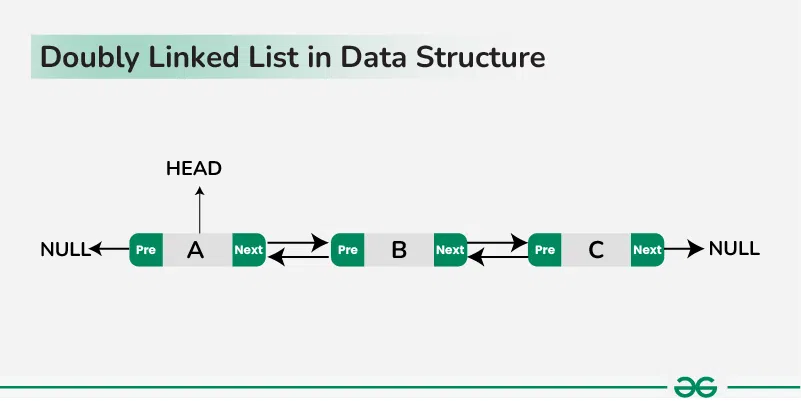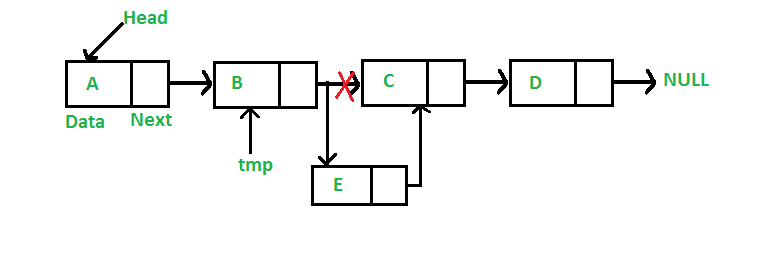[자료구조] Linked List 1편, Singly Linked List
Singly Linked List
링크드 리스트(Linked List)
- Sorted List에서 삽입, 삭제 연산을 빠르게 하기 위함
- Sorted List이어도 삽입, 삭제 연산보다 탐색 연산이 빈번하면 Array가 더 유리한 경우가 많음
- array는 연속적인 메모리 주소 마다 item을 저장하는 한편, linked list는 노드 당 1개의 item을 저장하고 각 노드는 다음 노드로 갈 수 있는 포인터를 가지고 있음
- 이때, n번재 item을 탐색하기 위해서는 1번째 포인터, 2번째 포인터, n-1번째 포인터를 모두 거쳐야 하므로 탐색에서는 불리
- iterator 혹은 pointer를 통한 삽입, 삭제 연산에서는 유리
- item 값을 통한 탐색 후 삽입, 삭제가 발생하는 경우 시간복잡도 증가

링크드 리스트(Linked List)에 필요한 Operator
- Constructor
- Linked List 객체 생성을 위한 생성자
- Destructor
- Linked List 객체 삭제를 위한 소멸자
- Transformer
- Linked List의 상태를 변환하는 변환자
- Observer
- Linked List의 아이템이나 길이 등의 정보에 접근하기 위한 관측자
Singly Linked List(SLL)
- Doubly Linked List에 앞서 특수한 상황을 위한 Linked List
- Doubly Linked List는 현재 노드의 전, 후 모두 이동 가능하나, Singly Linked List는 현재 노드의 후로만 이동 가능

Singly Linked List Search Algorithm
-
위 그림에서 Head를 현재 노드의 Next 포인터를 따라 한 칸씩 이동시키며 탐색
-
3번 째 item을 찾고자 한다면 아래와 같이 코드를 작성할 수 있을 것이다
- Node라는 별도의 구조체와 SLL이라는 클래스는 이미 있다고 가정하자
Node* cur_node = SLL.get_head(); // cur_node->item == 'A'
for(int i = 0; i < 2; i++) {
cur_node = cur_node->next;
}
// 0번째 iteration 종료 시, cur_node->item == 'B'
// 1번째 iteration 종료 시, cur_node->item == 'C'
cout << cur_node->item;
Singly Linked List Insertion Algorithm
Basic Idea

- 새로운 노드를 주어진 pos(포인터 혹은 이터레이터) 다음 위치에 넣으려한다
- ‘B’ 노드가 주어진 pos라 하자
- ‘B’ 노드 다음에 삽입한다는 것은 ‘B’와 ‘C’ 사이에 삽입한다는 것을 의미한다
- 우선 새로운 객체를 생성한다
- ‘B’노드의 next 포인터는 새로운 객체를 가리켜야 하고
- 새로운 객체의 next 포인터는 ‘C’노드를 가리켜야 한다
- 근데 ‘B’노드의 next 포인터를 먼저 새로운 객체를 가르키니 ‘C’ 노드의 행방이 묘연해졌다
- 이에 대한 2가지 솔루션이 있다
- Solution 1.
- 무지성으로 접근하면 temp_ptr을 생성해서 ‘C’ 노드로의 포인터를 저장
- Solution 2.
- 반대로 새로운 객체의 next 포인터가 ‘C’를 먼저 가르키게 한 뒤 ‘B’ 노드의 next포인터가 새로운 객체를 가르키게 한다
- 당연히 ‘Solution 2’가 교과서적인 접근이다
- Solution 1.
- ‘너무 쉽고도 당연한 solution 아닌가?’ 라고 생각될 수 있으나, Doubly Linked List의 Insertion 알고리즘에도 동일하게 적용되는 아이디어이다.
- 막상 Doubly Linked List를 보면 Insertion의 순서가 마냥 쉽게 떠올르진 않을 것이다
Step by Step
Step 1. 새로운 데이터를 저장할 노드 생성
Node* new_node = new Node(); // 새로운 노드 생성
new_node->item = new_item; // 새로운 노드에 주어진 아이템 삽입
Step 2. 주어진 위치의 다음 위치에 노드 삽입
Node* cur = pos.GetCurrent(); // 주어진 pos의 포인터 저장
new_node->next = cur->next; // 새로운 노드의 next 포인터는 현재 노드의 다음 노드를 지칭
cur->next = new_node; // 현재 노드의 next 포인터는 새로은 노드를 지칭
Source Code
void SLL::Insert(Iterator pos, ItemType new_item) {
if (IsFull()) {
cerr << "List is Full, bad_alloc exception" << endl;
return;
}
// pos == End()인 경우, 즉 current == nullptr이라면
// "pos 다음에 삽입"이 불가능하므로 예외적으로 처리
if (pos.GetCurrent() == nullptr) {
cerr << "Iterator is End(), cannot insert after the end of the list." << endl;
return;
}
Node* new_node = new Node(); // 새로운 노드 생성
new_node->item = new_item; // 새로운 노드에 주어진 아이템 삽입
// "pos 다음 위치"에 삽입
Node* cur = pos.GetCurrent(); // 주어진 pos의 포인터 저장
new_node->next = cur->next; // 새로운 노드의 next 포인터는 현재 노드의 다음 노드를 지칭
cur->next = new_node; // 현재 노드의 next 포인터는 새로은 노드를 지칭
size++;
}
Singly Linked List Deletion Algorithm
Deletion at the Beginning in Singly Linked List

-
주어진 pos(포인터 혹은 이터레이터)가 head인 경우
- 기존 head 포인터를 temp_ptr에 저장
- head는 head->next로 수정
- temp_ptr 메모리 해제 (기존 head 메모리 해제)
Node* temp_ptr = head; // 기존 head 포인터 임시 저장
head = head->next; // head 포인터를 head->next로 수정
delete temp_ptr; // 기존 head 삭제(메모리 할당 해제)
Deletion after a given node in Doubly Linked List

- 주어진 pos(포인터 혹은 이터레이터)의 노드를 삭제하려 한다
- 우선 삭제할 위치의 pos를 함수 파라미터로 받아온다
- ‘C’ 노드를 삭제하려면 우선 ‘B’ 노드가 ‘D’ 노드를 가리켜야 한다
- 이때, ‘C’ 노드를 삭제하려면 ‘B’ 노드를 가지고 있어야 한다
- 이에 대한 Solution은 2가지가 존재한다
- Solution 1.
Node* prev_node = head; while (prev_node->next != cur_node) { prev_node = prev_node->next; } prev_node->next = cur_node->next; delete cur_node;- ‘prev_node’의 next 포인터가 ‘C’를 위치하면 반복문을 종료한다
- 위 예시에서 ‘cur_node’는 ‘C’이다
- 반복문을 통해 ‘B’ 노드의 next 포인터가 ‘C’를 가르키면 ‘prev_node’가 ‘B’ 노드이게 된다
- 그러나, ‘Solution 1’을 사용했더니 아이템 삭제 시마다 $O(N)$ 복잡도가 발생한다
- Linked List의 장점이 사라졌다!!
- Solution 2.
Node* prev_node = pos.GetPrevious(); prev_node->next = cur_node->next; delete cur_node;- ‘pos’는 iterator 객체이다
- iterator를 통해 ‘pos’ 이전 객체의 정보를 관리하면 반복문이 불필요하다
- 이때, Singly Linked List는 어짜피 한 칸씩만 앞으로 이동 가능하므로 previous도 추적하여 관리가 가능하다
Singly Linked List Iterator Algorithm
Class Definition
class Iterator { // SLL 객체의 아이템 접근을 위한 iterator
private:
Node* current;
Node* previous;
public:
explicit Iterator(Node* node); // iterator 객체 생성자
SLL::Iterator& operator=(const Iterator& other); // iterator 복사 연산자
ItemType& operator*() const; // SLL Node의 item 접근을 위한 연산자 오버로딩
Iterator& operator++(); // SLL iterator가 다음 노드를 지시하도록 하기 위한 연산자 오버로딩
bool operator==(const Iterator& other) const; // SLL iterator가 지시하는 노드가 서로 동일한지 확인하는 연산자
bool operator!=(const Iterator& other) const; // SLL iterator가 지시하는 노드가 서로 다른지 확인하는 연산자
[[nodiscard]] Node* GetCurrent() const; // SLL iterator가 현재 지시하고 있는 노드의 포인터를 반환
[[nodiscard]] Node* GetPrevious() const; // 현재 지시하고 있는 노드의 이전 노드의 포인터를 반환
};
Constructor
- iterator 객체 생성자
SLL::Iterator::Iterator(Node* node) : current(node), previous(nullptr) {}
operator=
- iterator 객체 복사
SLL::Iterator &SLL::Iterator::operator=(const Iterator &other) {
if (this != &other) { // 자기 자신이 아닐 때만 복사 수행
current = other.current; // 현재 노드 복사
previous = other.previous; // 이전 노드 복사
}
return *this;
}
operator*
- 현재 iterator가 가르키는 노드의 데이터 반환
ItemType& SLL::Iterator::operator*() const {
return current->item;
}
operator++
- 현재 이터레이터가 가리키는 위치를 한칸 뒤로 이동
SLL::Iterator& SLL::Iterator::operator++() {
if (current != nullptr) {
previous = current;
// 이전 노드의 포인터를 직전의 현재 노드 정보를 활용하여 추적 관리
// 삭제 연산에 대비하기 위함
current = current->next; // 현재 노드 포인터 관리
}
return *this;
}
operator==, operator!=
- 서로 다른 두 이터레이터가 같은 노드를 가리키는지 확인
- 서로 다른 두 이터레이터가 다른 노드를 가리키는지 확인
bool SLL::Iterator::operator==(const Iterator& other) const {
return current == other.current;
}
bool SLL::Iterator::operator!=(const Iterator& other) const {
return current != other.current;
}
GetCurrent, GetPrevious
- 이터레이터의 current노드 포인터 반환
- 이터레이터의 previous노드 포인터 반환
Node* SLL::Iterator::GetCurrent() const {
return current;
}
Node* SLL::Iterator::GetPrevious() const {
return previous;
}
Singly Linked List(SLL)에 필요한 Operators
- Constructor
- Destructor
- Transformers
- insert
- erase
- Observers
- Iterator
- operator*
- operator++
- operator==
- operator!=
- GetCurrent
- IsEmpty
- IsFull
- SizeIs
- Iterator
Source Code
Preprocessing
#include <iostream>
using namespace std;
typedef int ItemType;
struct Node;
class SLL;
Node Struct
struct Node {
ItemType item = 0;
Node* next = nullptr;
};
Class Definition
class SLL {
private:
Node* head = nullptr;
size_t size = 0;
public:
class Iterator { // SLL 객체의 아이템 접근을 위한 iterator
private:
Node* current;
Node* previous;
public:
explicit Iterator(Node* node); // iterator 객체 생성자
SLL::Iterator& operator=(const Iterator& other); // iterator 복사 연산자
ItemType& operator*() const; // SLL Node의 item 접근을 위한 연산자 오버로딩
Iterator& operator++(); // SLL iterator가 다음 노드를 지시하도록 하기 위한 연산자 오버로딩
bool operator==(const Iterator& other) const; // SLL iterator가 지시하는 노드가 서로 동일한지 확인하는 연산자
bool operator!=(const Iterator& other) const; // SLL iterator가 지시하는 노드가 서로 다른지 확인하는 연산자
[[nodiscard]] Node* GetCurrent() const; // SLL iterator가 현재 지시하고 있는 노드의 포인터를 반환
[[nodiscard]] Node* GetPrevious() const; // 현재 지시하고 있는 노드의 이전 노드의 포인터를 반환
};
explicit SLL(ItemType root_item);
~SLL();
[[nodiscard]] bool IsFull() const; // SLL이 가득 차 있는지 확인
[[nodiscard]] bool IsEmpty() const; // SLL이 비어있는지 확인
[[nodiscard]] size_t SizeIs() const; // SLL의 크기 반환
void Insert(Iterator pos, ItemType new_item); // SLL에 아이템 삽입
void Erase(Iterator pos); // SLL의 아이템 삭제
[[nodiscard]] Iterator Begin() const { return Iterator(head); } // SLL의 처음 시작위치 반환
[[nodiscard]] Iterator End() const { return Iterator(nullptr); } // SLL의 마지막 위치 반환(nullptr)
};
Iterator Implementation
SLL::Iterator::Iterator(Node* node) : current(node), previous(nullptr) {}
SLL::Iterator &SLL::Iterator::operator=(const Iterator &other) {
if (this != &other) { // 자기 자신이 아닐 때만 복사 수행
current = other.current; // 현재 노드 복사
previous = other.previous; // 이전 노드 복사
}
return *this;
}
ItemType& SLL::Iterator::operator*() const {
return current->item;
}
SLL::Iterator& SLL::Iterator::operator++() {
if (current != nullptr) {
previous = current;
// 이전 노드의 포인터를 직전의 현재 노드 정보를 활용하여 추적 관리
// 삭제 연산에 대비하기 위함
current = current->next; // 현재 노드 포인터 관리
}
return *this;
}
bool SLL::Iterator::operator==(const Iterator& other) const {
return current == other.current;
}
bool SLL::Iterator::operator!=(const Iterator& other) const {
return current != other.current;
}
Node* SLL::Iterator::GetCurrent() const {
return current;
}
Node* SLL::Iterator::GetPrevious() const {
return previous;
}
SLL Constructor
SLL::SLL(const ItemType root_item) {
head = new Node();
head->item = root_item;
head->next = nullptr;
size++;
}
SLL Destructor
SLL::~SLL() {
Node* cur_node = head;
while(cur_node != nullptr) {
Node* temp_ptr = cur_node->next;
delete cur_node;
cur_node = temp_ptr;
}
}
SLL Observer
bool SLL::IsFull() const {
try {
const Node* dummy_node = new Node(); // dummy_node가 생성 가능하면 false 반환
delete dummy_node;
return false;
}
catch(const bad_alloc& e) { // dummy_node가 생성되지 않고 bad_alloc exception 발생
return true; // true 반환
}
}
bool SLL::IsEmpty() const {
return head == nullptr;
}
size_t SLL::SizeIs() const {
return size;
}
SLL Transformer
void SLL::Insert(Iterator pos, ItemType new_item) {
if (IsFull()) {
cerr << "List is Full, bad_alloc exception" << endl;
return;
}
// pos == End()인 경우, 즉 current == nullptr이라면
// "pos 다음에 삽입"이 불가능하므로 예외적으로 처리
if (pos.GetCurrent() == nullptr) {
cerr << "Iterator is End(), cannot insert after the end of the list." << endl;
return;
}
Node* new_node = new Node(); // 새로운 노드 생성
new_node->item = new_item; // 새로운 노드에 주어진 아이템 삽입
// "pos 다음 위치"에 삽입
Node* cur = pos.GetCurrent(); // 주어진 pos의 포인터 저장
new_node->next = cur->next; // 새로운 노드의 next 포인터는 현재 노드의 다음 노드를 지칭
cur->next = new_node; // 현재 노드의 next 포인터는 새로은 노드를 지칭
size++;
}
void SLL::Erase(Iterator pos) {
if (IsEmpty() || pos.GetCurrent() == nullptr) {
cerr << "List is empty or invalid iterator, nothing to erase." << endl;
return;
}
// pos == Begin()인 경우, 즉 current == head이라면
if (pos.GetCurrent() == head) {
Node* temp_ptr = head; // 기존 head 포인터 임시 저장
head = head->next; // head 포인터를 head->next로 수정
delete temp_ptr; // 기존 head 삭제(메모리 할당 해제)
}
// pos != Begin()인 경우, 즉 current != head이라면
else {
Node* prev_node = pos.GetPrevious(); // 현재 노드의 이전 노드 포인터 저장
// 이전 노드가 nullptr이 아니라면 삭제 연산 수행
// (head가 아니면서 이전 노드가 nullptr일 순 없으나, 만일의 경우를 대비한 예외처리)
if (prev_node != nullptr) {
prev_node->next = pos.GetCurrent()->next;
// 이전 노드의 next 포인터가 현재 노드의 다음 노드 지칭하도록 수정
// 현재 노드를 건너뛰게됨
delete pos.GetCurrent(); // 현재 노드 삭제
}
}
size--;
}
Main Function
int main() {
SLL list(5);
SLL::Iterator it1 = list.Begin();
list.Insert(it1, 10);
list.Insert(++it1, 15);
list.Insert(++it1, 20);
cout << "List Size: " << list.SizeIs() << endl;
for (SLL::Iterator it = list.Begin(); it != list.End(); ++it) {
cout << *it << " ";
}
cout << endl;
SLL::Iterator it2 = list.Begin();
++it2; // 두 번째 노드(10)로 이동
SLL::Iterator it3 = it2; // operator=()로 상태 복사
++it3; // 복사된 이터레이터로 다음 노드(15)로 이동
cout << "Current item in it2: " << *it2 << endl; // 10
cout << "Current item in it3: " << *it3 << endl; // 15
return EXIT_SUCCESS;
}
Result
List Size: 4
5 10 15 20
Current item in it2: 10
Current item in it3: 15
참고문헌
- Nell Dale. (2016). “C++ Plus Data Structues Sixth Edition”. Jones&Bartlett Learning.
- GeeksforGeeks. (2024). “Singly Linked List Data Structure”. https://www.geeksforgeeks.org/applications-of-linked-list-data-structure/.
- GeeksforGeeks. (2024). “What are real life exaples of double linked list”. https://www.geeksforgeeks.org/what-are-real-life-examples-of-double-linked-list/.
- OpenAI. (2024). ChatGPT(Aug 8, 2024). GPT-4o. https://chat.openai.com.
- meongju0o0. (2024). “singly_linked_list.cpp”. https://github.com/meongju0o0/meongju0o0-data-structure.


댓글남기기